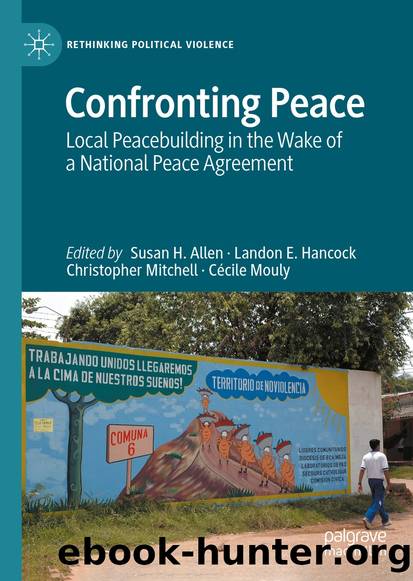Confronting Peace by Unknown

Author:Unknown
Language: eng
Format: epub
ISBN: 9783030672881
Publisher: Springer International Publishing
Over the next four years, 80% of the agenda was implemented.
Local Reponses to an Imminent Peace Agreement, 2010â2016
The national elections of 2010 produced a new government in Bogotá under President Santos, whichâsomewhat to everyoneâs surpriseâreversed the direction of the previous government of President Alvaro Uribe and started to seek a negotiated settlement with the insurgent groups, starting with the weakened guerrillas of the FARC. Talks began in Havana, Cuba, in 2012 and after a long drawn-out negotiating process concluded with the Havana Accord, signed in December 2016.
With this as background, the local community in Granada continued its local peacebuilding work, strengthening its rural and urban-rural networks, extending many existing programs within the municipality, and starting up new initiatives, some of which were established in the hope that the national-level negotiations in Havana would succeed in bringing some form of peace to conflict-afflicted regions.
In July 2011, for example, all mayoral and council candidates were asked to sign a transparency agreement and to commit to including community proposals in their government planâif elected. The candidate who included 99% of the proposals in his bid was indeed elected mayor for the 2012â2015 term. Subsequently, the communityâs proposals were included in his Municipal Development Plan. The participatory construction of the overall political agenda, âOur Municipality, Everyoneâs Home,â represented a profound shift for Granadaâs RHNs, and is the direct result of the peace infrastructure traced in this study. This process required harnessing the legitimacy of the networks in the mobilization for peace and justice.20
In 2012, the municipal administration asked Edwin Giraldo to implement the More Sport, Less Mines tournament again. The Santa Ana Sports Committee was established in February 2013 to coordinate different activities, such as youth weeks, aerobics classes, youth groups, and village accompaniment groups, and generally to support recreation and physical education for the municipality. That same year, the municipality declared a state of emergency to support the returning of those forcibly displaced. Different entities (local, regional, departmental, and national) jointly supported the return, together with individual accompaniment for more than 350 families returning to their lands. As RHNs in Granada mobilized to respond to this emergency, the community proposals included in the municipal plan took center stage. RHN action in this response was a first step in a major evolution of Granadaâs peace infrastructure, one which would help develop the networksâ latent capacities in the post-agreement period.
The period between 2010 and 2016 was thus marked by existing rural-urban human networks, such as ASOVIDA, responding with overt forms of resistance and reconstruction. Resonating in and through the webs of relationships was a dynamic process of harmonization that moved from internal (individual) to external contexts. As the next section will show, ASOVIDAâs history is born out of a psychosocial process of support through accompaniment, listening, and mutual support.
Of the âkey challenges an infrastructure for peace must address, the most significant remains how to provide for robust creativity and adaptive capacity in the wider system of change rather than focusing narrowly on institution buildingâ (Lederach 2012: 12).
Download
This site does not store any files on its server. We only index and link to content provided by other sites. Please contact the content providers to delete copyright contents if any and email us, we'll remove relevant links or contents immediately.
Harry Potter and the Goblet Of Fire by J.K. Rowling(3024)
Unfinished: A Memoir by Priyanka Chopra Jonas(2911)
Never by Ken Follett(2872)
The Man Who Died Twice by Richard Osman(2289)
Machine Learning at Scale with H2O by Gregory Keys | David Whiting(2264)
Fairy Tale by Stephen King(2058)
Will by Will Smith(2032)
Rationality by Steven Pinker(1760)
The Storyteller by Dave Grohl(1656)
The Dawn of Everything: A New History of Humanity by David Graeber & David Wengrow(1564)
The Dark Hours by Michael Connelly(1562)
The Stranger in the Lifeboat by Mitch Albom(1529)
Cloud Cuckoo Land by Anthony Doerr(1428)
The Becoming by Nora Roberts(1323)
Friends, Lovers, and the Big Terrible Thing by Matthew Perry(1321)
Crying in H Mart by Michelle Zauner(1312)
Einstein: His Life and Universe by Walter Isaacson(1311)
New Morning Mercies: A Daily Gospel Devotional by Paul David Tripp(1301)
A Short History of War by Jeremy Black(1295)
